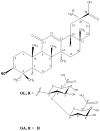In silico and in vivo anti-malarial studies of 18β glycyrrhetinic acid from Glycyrrhiza glabra
- PMID: 24086367
- PMCID: PMC3782471
- DOI: 10.1371/journal.pone.0074761
In silico and in vivo anti-malarial studies of 18β glycyrrhetinic acid from Glycyrrhiza glabra
Abstract
Malaria is one of the most prevailing fatal diseases causing between 1.2 and 2.7 million deaths all over the world each year. Further, development of resistance against the frontline anti-malarial drugs has created an alarming situation, which requires intensive drug discovery to develop new, more effective, affordable and accessible anti-malarial agents possessing novel modes of action. Over the past few years triterpenoids from higher plants have shown a wide range of anti-malarial activities. As a part of our drug discovery program for anti-malarial agents from Indian medicinal plants, roots of Glycyrrhizaglabra were chemically investigated, which resulted in the isolation and characterization of 18β-glycyrrhetinic acid (GA) as a major constituent. The in vitro studies against P. falciparum showed significant (IC50 1.69 µg/ml) anti-malarial potential for GA. Similarly, the molecular docking studies showed adequate docking (LibDock) score of 71.18 for GA and 131.15 for standard anti-malarial drug chloroquine. Further, in silico pharmacokinetic and drug-likeness studies showed that GA possesses drug-like properties. Finally, in vivo evaluation showed a dose dependent anti-malarial activity ranging from 68-100% at doses of 62.5-250 mg/kg on day 8. To the best of our knowledge this is the first ever report on the anti-malarial potential of GA. Further work on optimization of the anti-malarial lead is under progress.
Conflict of interest statement
Figures






References
-
- Daily JP (2006) Antimalarial drug therapy: the role of parasite biology and drug resistance. J Clin Pharmacol 46: 1487-1497. doi:10.1177/0091270006294276. PubMed: 17101748. - DOI - PubMed
-
- W.H.O. (2012) orld Malaria Report 2012. Available at: http://www.who.int/malaria/publications/world_malaria_report_2012/report/en/wmr2012_full_report.pdf. Accessed: August /2013.
-
- Penna-Coutinho J, Cortopassi WA, Oliveira AA, França TC, Krettli AU (2011) Antimalarial activity of potential inhibitors of Plasmodium falciparum lactate dehydrogenase enzyme selected by docking studies. PLOS ONE 6: e21237. doi:10.1371/journal.pone.0021237. PubMed: 21779323. - DOI - PMC - PubMed
-
- Gardner MJ, Hall N, Fung E, White O, Berriman M et al. (2002) Genome sequence of the human malaria parasite Plasmodium falciparum. Nature 419: 498–511. doi:10.1038/nature01097. PubMed: 12368864. - DOI - PMC - PubMed
-
- Takenaka T (2001) Classical vs reverse pharmacology in drug discovery. BJU Int 88 (Suppl 2): 7-10; discussion 49-50 doi:10.1111/j.1464-410X.2001.00112.x. PubMed: 11589663. - DOI - PubMed
Publication types
MeSH terms
Substances
LinkOut - more resources
Full Text Sources
Other Literature Sources
Research Materials
Miscellaneous

